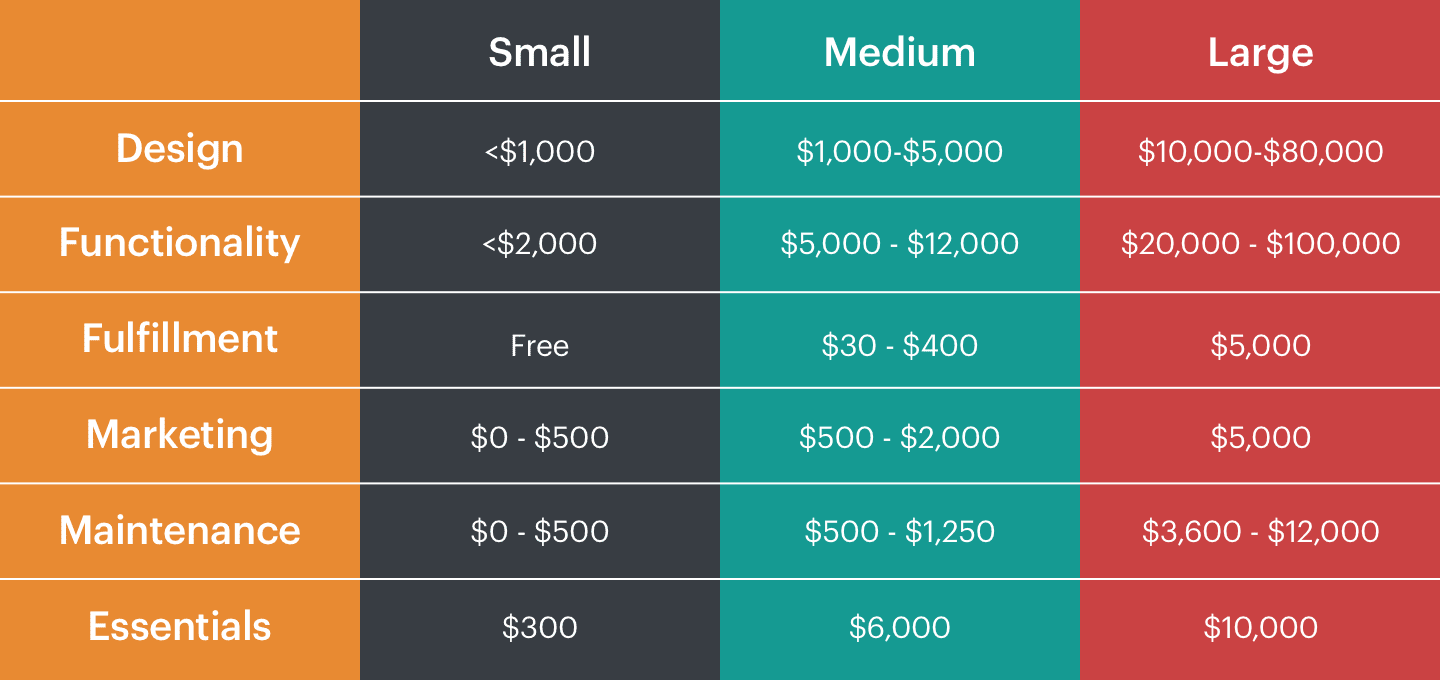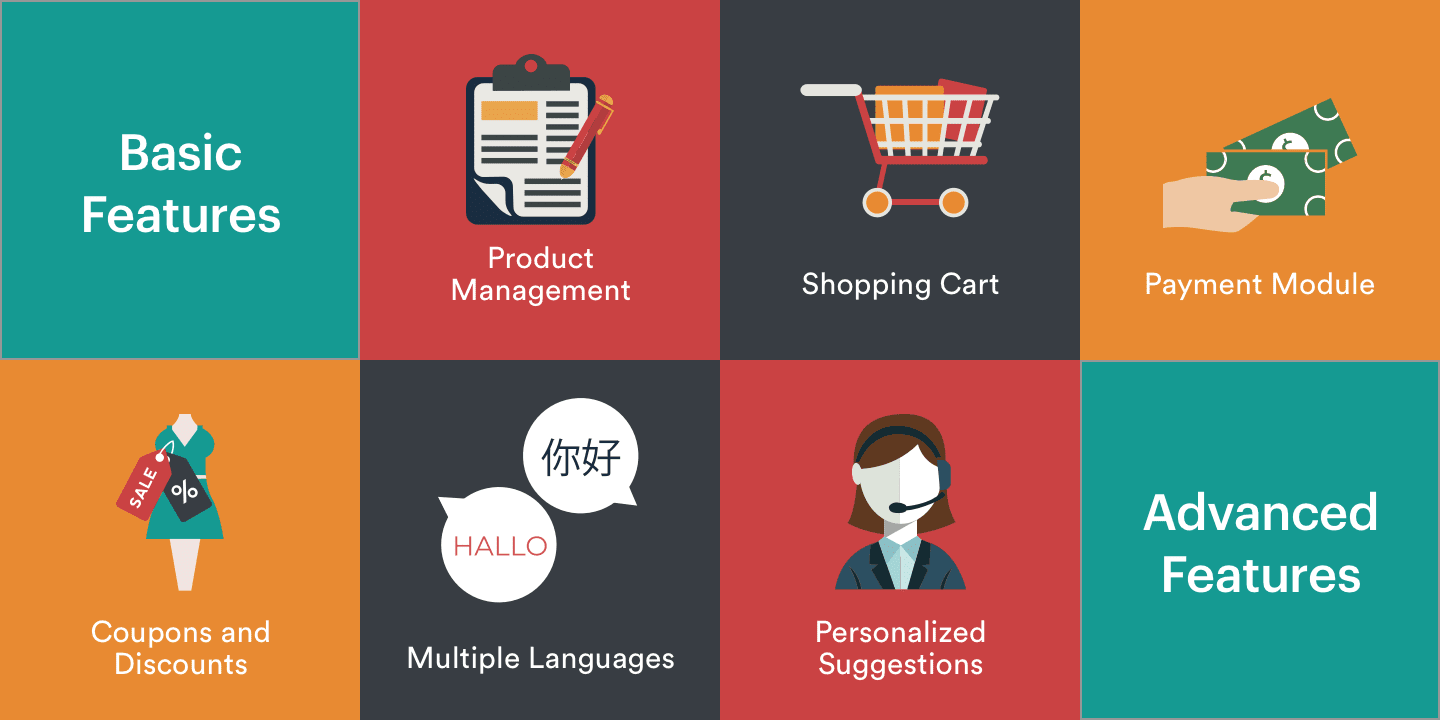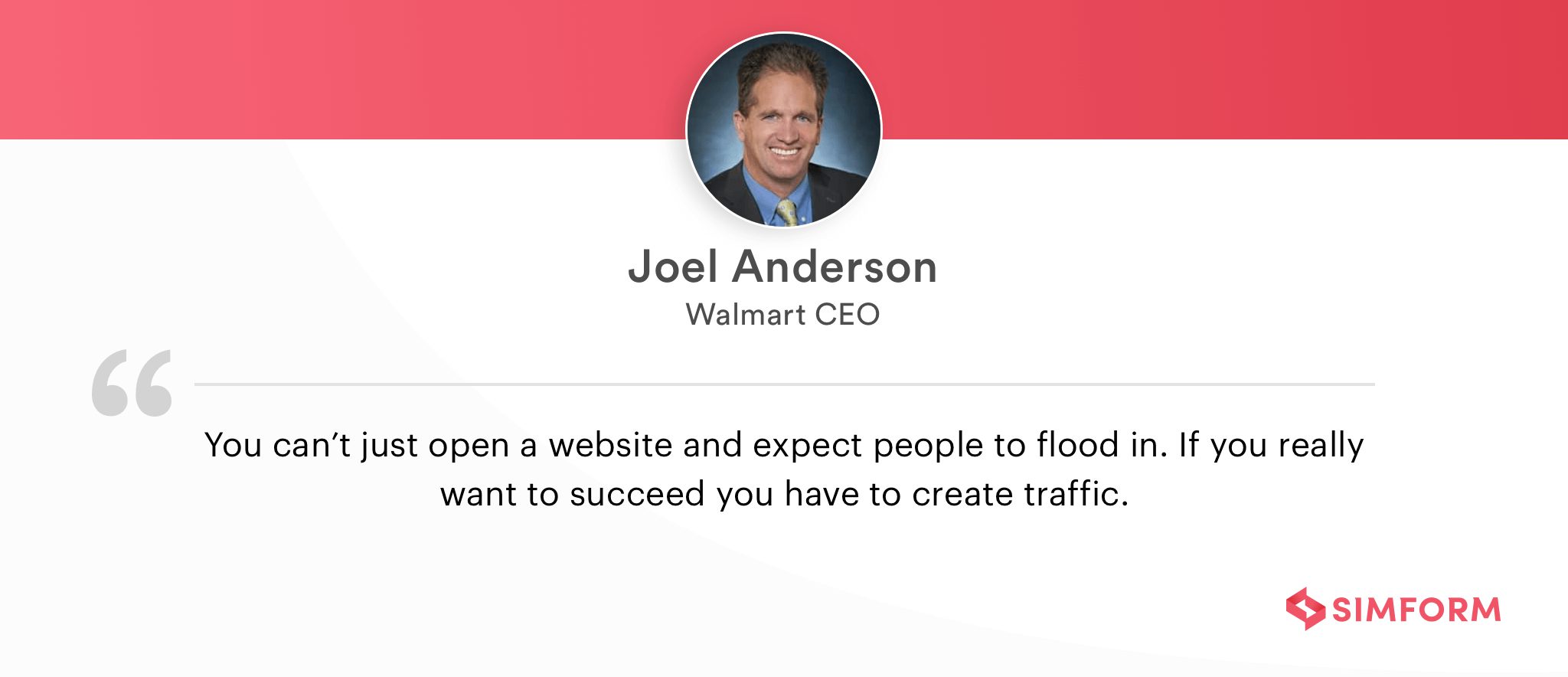How Much To Create An Ecommerce Website
What was the first question that popped up in your head when you decided to build an eCommerce website?
Was it about the website design? Or were you thinking about the marketing strategy? Probably none of these. The most significant concern is usually the eCommerce website development cost. No wonder you are here reading this article.
An eCommerce website pricing will be somewhere between $5,000 and $200,000 and even more in some instances. I know it isn't a very precise estimate, but that's because of the vague question. You might come up with a similar cost estimate if I ask you how much a car costs, isn't it?
Editor's note: To discuss estimated eCommerce Website Costs and know more about optimal cost management. Feel free to share your requirements with Simform's eCommerce experts .
To reach a reasonable range of cost, you'd need to answer a few questions.:
- What's the scale of the website going to be?
- What kind of traffic do you expect?
- How soon do you want it to be ready?
- Do you want to develop a custom website or wish to use a SaaS platform such as Shopify instead?
- How much emphasis will be put on the design?
- What additional features do you want on the website?
- How many products will be listed on the website?
- What kind of marketing strategy do you want to follow?
You'll get closer to the right figure by answering these questions, but you need to answer plenty more to hit the bull's eye. Keep reading to find out how various features and stages of development affect the total cost of building an eCommerce website or eCommerce software.
Scale of your eCommerce Website and Suitable Method of Development
The internet is home to all kinds of eCommerce businesses. You will find online stores revolving around a singular product and also ones that seem to sell everything under the sun. It's evident that these websites have varying scopes and goals and, therefore, employ different methods of website building.
Before you begin the cost estimation, you need to identify where you stand in the eCommerce landscape. Are you a startup without a massive capital backup? Or do you have a successful retail business that you wish to take online? Financial independence is key to determine how close you get to the ideal website you have in mind.
Another driving factor is the method of building the website. The options are – Open-Source and SaaS eCommerce platforms and custom eCommerce development. These methods come with their own set of pros and cons that you'll get to understand better as we move along with the article.
Cost Breakdown of eCommerce Websites
 The table above gives a great deal of insight into how the cost varies from one case to another. It's the functionality section where you could cut cost the most by going with SaaS eCommerce platforms such as Spotify. These platforms will save you a lot of time and money, but they aren't the ideal option if you want your eCommerce store to stand out. However, you can counter this demerit through customization, and also scale as per requirements.
The table above gives a great deal of insight into how the cost varies from one case to another. It's the functionality section where you could cut cost the most by going with SaaS eCommerce platforms such as Spotify. These platforms will save you a lot of time and money, but they aren't the ideal option if you want your eCommerce store to stand out. However, you can counter this demerit through customization, and also scale as per requirements.
On the other hand, the sky's the limit when it comes to custom development. There are no boundaries in terms of features, cost, and time. Even though you can customize various aspects of your SaaS-based store, custom development will always be more flexible and effective.
Let's have a closer look at the different elements of an eCommerce website, and how they impact the overall cost:
Check how we help Stubbs & Wootton - a luxury shoe brand go digital within just 6 months
Design: Cost of Website Cosmetics
Netizens have very short attention spans, thanks to the plethora of options available for everything. To make these individuals halt and make purchases, the store needs to be impressive from the get-go. And the design can very well be the factor that makes your website stand out from the rest and, therefore, drive more sales.
By leveraging eCommerce platforms like Shopify and WooCommerce, one can build magnificent web design without spending a single penny. These platforms come with free themes that come in handy for those walking on a budgetary tightrope. Some of these free themes look amazing too; however, the cookie-cutter options eventually prove insufficient achieving only the bare minimum.
Another option is to get one of the paid themes. A Shopify theme would cost you somewhere between $140 to $180. Such themes are more professional and rare compared to the free ones. Moreover, you can take them a couple of notches higher by customizing them. You can expect to shell out $1,000 for minor changes and branding the theme. And if you are looking to introduce a wider variety of changes, then the customization will cost north of $5,000.
For custom development, there is no limit to designing cost. It all depends on how engaging you want the UX to be. If you're a retailer planning to take your brick and mortar store online, then brand perception matters even more. Custom designing costs begin from $10,000 and go up to thousands of dollars. The price for design also varies with features. Numbers such as $30,000 and $75,000 aren't exactly ludicrous for an eCommerce-website design.
Functionality: The Price Varies with Basic and Advanced eCommerce Features
With the design side sorted, let's get to the core of an eCommerce website. No matter how simple or advanced the store you wish to create, it has to have some basic features. The basic functionality marks the need for product management, shopping cart, a payment module, and other key features.
If you're going for a simple eCommerce website, then you'll discover that most features are already there. But who wants a cookie cutter store, right? Irrespective of the eCommerce platform you use, there will always be plenty of gaps in terms of functionality.
 This is where plugins and add-ons come in handy. You can easily find both free and paid add-ons to improve the functionality of the site. This is also where things get tricky. The free ones aren't very good. Since third parties usually develop the paid ones, they don't always go well with a website.
This is where plugins and add-ons come in handy. You can easily find both free and paid add-ons to improve the functionality of the site. This is also where things get tricky. The free ones aren't very good. Since third parties usually develop the paid ones, they don't always go well with a website.
The solution, you ask? It's customization!
Basic features: SaaS platforms
Just the way it was with themes, you can also hire developers to customize the add-on for your site. They could even create one from scratch. The two options depend on what you need. The customization for basic eCommerce features on platforms like Shopify and WooCommerce can cost between $5,000 and $15,000.
But there's more — most eCommerce-website owners don't want to settle just for basic features. After all, who would like an online store without a wishlist or a site that is unable to provide discounts?
Advanced features: SaaS platforms
Customizing advanced features requires a bigger budget. If you have a decent eCommerce website budget, you should go with customization. The more functional the website, the easier it becomes to attract customers. For this bump, you'd need to pay an extra $5,000 to $12,000.
Having said that, there aren't very many changes when you move from eCommerce platforms to custom eCommerce development, and the importance of basic and advanced features remains the same.
Basic features: custom development
The average cost of primary-eCommerce features for custom development ranges between $20,000 and $30,000. They include features like product management, product categorisation, payment portal, and the like.
Advanced features: custom development
However, if you wish to augment your basic custom eCommerce website with advanced features, this upgrade will cost around $10,000 to $16,000. Discount management, personalized suggestions, wishlist management, and multiple languages are some of these advanced features.
Since this section is among the more expensive ones, put in the due diligence while choosing the right platform. Simform has a decade long experience in custom development and can expertly guide you through the process.
Custom Shopping Cart 101: How to Implement It in the Most Profitable Way
Fulfillment: The Cost of Tying in Physical and Digital Ends of the Store
To run a successful eCommerce business, a great website is only half the battle won. You need to stay true to all the promises you made. This means delivering on time, upholding product quality, and providing competent customer service even after the purchase. And if you don't hold your side of the bargain, you can't stay in the game for long.
Fulfillment service is going to be the backbone to your eCommerce business. And even though it won't have much to do with the website, you need to make sure that your fulfillment software is in sync with it.
It should automatically update inventory status, send out notifications, seamlessly interact with delivery partners, and generate accurate invoices. And this list has just the bare minimum actions.
You can either get an eCommerce-fulfillment software or get one custom developed. Most fulfillments come with a monthly subscription plan. It works well for most eCommerce startups as they can always scale later, thus, saving a handsome amount during initial stages. .
Options are available in quite the range. You can get one for as low as $30 per month and as high as $400 per month. There are also a few which charge a one-time license fee. These alternatives could charge you around $5,000. And if you decide to get it custom developed, this cost will also be in the vicinity of $5,000
Marketing: Different Methods, Different Costs
So you did your homework and launched a great-looking website, but customers are not particularly flocking to it or raving about it. So what happened?.
 You have to attract shoppers to your eCommerce website, especially at the beginning to gain some traction. A lot falls under the marketing umbrella — everything from the web copy to a PPC campaign is capable of generating traffic.
You have to attract shoppers to your eCommerce website, especially at the beginning to gain some traction. A lot falls under the marketing umbrella — everything from the web copy to a PPC campaign is capable of generating traffic.
Let's start with SEO and copywriting. The cost of copywriting is directly proportional to the number of pages and is more like a one-time investment. SEO, on the other hand, is a dynamic process: you need to keep at it for as long as the store is functional.
SEO and copywriting will depend a lot on the scale of the website. If you're a small eCommerce startup with a limited budget, you can take care of them yourself. Just put in some effort, and you're golden. No need to spend any money either!
For medium and large businesses, marketing plays a more prominent role. They go beyond SEO and invest in PPC campaigns, remarketing themselves, and other digital-marketing strategies. Some create blogs while others resort to email marketing. There are just so many ways to get the job done.
The cost of marketing can amount up to $500 to $2,000 for a small store whereas it can shoot up in the range of $4,000 to $5,000 for bigger eCommerce websites.
Maintenance: Cost to Keep on Keeping on
Once the website is up and running, it will naturally require timely attention and maintenance. This is important because some flaws get exposed only after the website goes live with products. Plus, regular updates keep the website competitive.
Just like other aspects of building an eCommerce website, maintenance is also dependent on its scale. Smaller stores, especially those built on eCommerce platforms, don't need extensive technical maintenance from your side. You can leave that to the service provider and focus on the business instead.
For sites with any extent of customization, maintenance is a critical part of the deal. Regular inspections and updates ensure everything runs smoothly, and you don't encounter any unwanted surprises.
Apart from tech-maintenance costs, there are expenses for store maintenance as well. Bigger businesses might need to train and employ customer-support executives to upgrade their service. Random bugs and glitches also add up to the website maintenance costs.
So if you have a small to medium-sized enterprise, expect to shell out around $500 to $1,250 per year on maintenance. And if you own a large eCommerce business with multiple products and huge traffic, the maintenance would cost in the whereabouts of $300 to $1,000 per month.
Other Essentials: Miscellaneous Spendings
Let's also discuss prerequisites. And these apply not just to eCommerce websites but to websites in general.
First off, you'll need a domain and hosting to get going. SaaS platforms such as Shopify and BigCommerce normally include hosting within the plan. The hosting solutions provided by SaaS eCommerce platforms don't need any effort to set up either. Everything is ready to use, and you can start working on the store right away. They even include an SSL certificate, which is a great perk. However, it's a good idea to go through the details of their hosting plans carefully. The plans either come with a monetary limit on the sales or allow just their preferred payment gateway.
For instance, Shopify requires you to use Shopify payments. You'll have to give up an additional 2% of the sale if you go for any other payment method. However, such a small fee can compound to a considerable sum over time. So keep this detail in mind while scouting around for an eCommerce hosting plan.
The hosting cost for SaaS platforms starts around $30 per month, and the premium plans can go up to $300 per month.
You also have the option to self-host the website. You'll find plenty of hosting services that have specific plans catering to eCommerce websites. You can easily scale these plans as and when needed, and you pay only for what you use. The only downside of self-hosting is the tremendous legwork it needs. Even though the hosting provider will help you with the set up, you'll still have to manage most things by yourself.
Self-hosting also comes with a wide range of plans that cost anywhere between $75 to $10,000 per year. It all depends on the scale of your website.
Cheaper hosting plans won't include the SSL certificate, so you'll have to get them separately. The higher-end SSL certificates which take care of everything are priced somewhere around $75 a year. Besides, your domain name will cost you between $7 and $15 a year. However, there are instances when domain names can go for thousands of dollars. It normally happens if you want to acquire a domain name that's already taken.
How can Simform Help Build your eCommerce Website?
Building or augmenting your eCommerce website can become a daunting task very quickly. Naturally, you need a reliable and experienced partner to shoulder this responsibility. And when it comes to eCommerce-website development, Simforms ticks all the right boxes.
Be it developing a custom website, working on a SaaS platform like Shopify or creating an eCommerce store on Magento, Simform has it covered. We use agile development methodology and sprint planning for swift delivery of projects. And during these developmental stages, you constantly remain aware of the progress with timely stand-ups and weekly demos. We're a one-stop shop for all your responsive design, development, and maintenance needs.
Here are some definitive ways Simform can help in your next eCommerce project:
- eCommerce strategy and consulting: Get in touch with our eCommerce experts to devise the best strategy for your business. Receive realistic quotations and practical plans to take your store to the next level.
- Custom eCommerce-storefront design : Our designers create visually pleasing templates, which drive more sales. We can help bring all the right kind of attention to your store and enhance the brand image.
- Custom shopping-cart development : Say goodbye to the high rate of shopping-cart abandonment with our custom shopping carts that engage customers and prompt them toward the sale.
- CMS development : We can develop and integrate CMS (Content Management System) to your eCommerce website. Forget about multiple data points. You can even implement headless eCommerce if you want.
- 3rd-party integrations : There are so many moving parts to an eCommerce website that you eventually need 3rd party plugins to fill in the gaps. We will help you with development as well as integration of this nature.
- Dedicated ERP system : We will create a centralized solution to tie the physical and digital ends of your eCommerce business. An ERP (Enterprise Resource Planning) system is exactly what you need to bring fulfillment and functionality in sync.
So feel free to contact us with your eCommerce website development needs.
Let's build a highly performant e-commerce website!
How Much To Create An Ecommerce Website
Source: https://www.simform.com/blog/ecommerce-website-cost/
Posted by: paigewilier88.blogspot.com

0 Response to "How Much To Create An Ecommerce Website"
Post a Comment